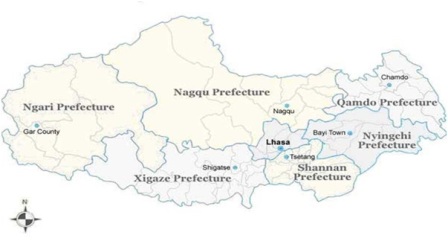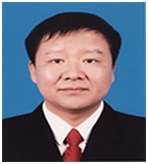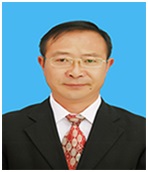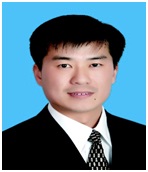The Tibet Insight News

Map: Administrative division of Tibet by CCP
Summary
TAR and Lhasa
Meeting to promote rule of law
The TAR Politics and Law Committee held a symposium on April 23 to promote the rule of law. TAR Party Secretary Wu Yingjie delivered a speech. He stressed the need to thoroughly study and implement General Secretary Xi Jinping’s speeches and urged officials to promote the rule of law and socialism with Chinese characteristics. The Vice Chairman of TAR Party Committee and Secretary of the Politics and Law Committee, Deng Xiaogang, presided.
The symposium discussed various issues concerning TAR. These included strengthening the Monastic Management Committees, educating monks and nuns in socialist principles, creating innovative and practical mechanisms to fight against “separatism” and crushing “hostile forces and the Dalai Clique,”
Officials of the Tibet Military District, Tibet Public Security Frontier Corps, the Political and Law Departments of the respective districts and counties, Tibet Military District’s Political Department and the Air Force Command Post of Lhasa, all attended the symposium.
Interview with the new TAR People’s Government head
Qi Zhala (Tib: Dralha) Chairman of the Tibet Autonomous Region (TAR) People’s Government, was jointly interviewed by China's Tibet magazine and China Tibet Online. During the interview, Qi Zhala expressed his views on Tibet's ecological environment, poverty alleviation work, Tibetan cultural protection and heritage and other issues. Describing Nagchu as the inner circle of ‘China's Water Tower' and ‘Asia's Water Tower', he said protection of its ecological environment is of paramount importance. He also said it is Tibet's ‘most concentrated poor area’ and that severe poverty stretches for miles.
Calling Tibetan culture a “shining pearl of Chinese culture”, he said the government had transformed the ancient cities, with the old city of Lhasa, including the whole of Lhasa, Shannan (Tib:Lhoka), Qamdo(Tib: Chamdo) and other places, as the focus.
(Comment: The Chinese Communist Party announced the appointment of Qi Zhala (CheDhalha) as the new Chairman of TAR on January 15, 2017, making him the second most powerful figure in TAR. According to Xinhua, the 58-year old politician replaces LosangJamcan (LobsangGyaltsen), who was elected chairman of the Standing Committee of the Tibet People's Congress the same day. Qi Zhala, who is a Tibetan and hails from Yunnan Province, as head of Lhasa imposed stringent restrictive measures and maintained an iron grip over Lhasa city.)
Religion Related News
Restrictions On Tibetan Monks And Nuns
Radio Free Asia (RFA) claimed on March 29, 2017, that many of the monks and nuns already expelled fromLarung Gar and the nearby religious community at Yachen Gar, both in Tibetan areas of Sichuan province, have been forced to return to the Tibet Autonomous Region (TAR) and subjected to exceptional restrictions on their liberty and to degrading treatment. It said that in November 2016, the authorities forced at least one group to undergo political re-education and apparent public humiliation in Nyingtri (Linzhi in Chinese), in southeastern TAR. The RFA report quoted a senior abbot as saying in a speech to the community on March 23 that the monks and nuns “who have left had never wanted to leave... And whether or not they had some place to go, they still had to leave". Saying that "the demolitions and expulsions come from the policy of the senior levels of government, and cannot be discussed”, he called on all monks and nuns to “show great forbearance and not react with protest, suicide and the like.” In a talk on March 29,( a recording of which was obtained by RFA’s Tibetan Service) the abbot said “Tomorrow [March 30, 2017], the head of Sichuan province is coming to review the demolition work begun on March 24 by Chinese government workers and laborers. Since most of the members of our community are young, you should all concentrate on your religious practice and studies and remain peaceful.” A video circulated on social media shows 25 young Tibetan women with shaven heads, who appear to be nuns, dressed in military jackets and standing in rows inside a police or government office decorated in Tibetan style. The women are shown chanting: “The Tibetans and the Chinese are daughters of the same mother, the name of the mother is China.” A photograph circulated at the same time shows the same women, dressed in full military fatigues, carrying out a military-style exercise inside a walled compound. A second video, circulated a few days after the first, shows 12 Tibetan nuns dancing on the stage of a theater in front of what appears to be an audience of officials. Dressed in religious robes, the nuns performed a choreographed dance routine to “The Song of the Emancipated Serfs.” A banner above the stage reads “Graduation Art Show for the Law and Politics Training Course for Buddhist Monks and Nuns, KongpoGyamda County.” KongpoGyamdacounty (Gongbujiangda in Chinese) is in Nyingtri municipality. The video is believed to have been filmed there on November 10, 2016.
Human Rights Watch also says that no former monks and nuns who have been returned to the TAR are allowed to join any monastery or nunnery there, which means they are considered to be “mobile religious personnel.” An official announcement in September 2012, directed that such unaffiliated monks and nuns are not permitted to carry out religious rituals in the TAR outside their own homes unless they have a special permit.
(Comment: “The Song of the Emancipated Serfs” is associated with official Chinese Communist Party celebrations and was originally performed in front of Chairman Mao Zedong in Beijing in 1959. Buddhist nuns usually make a commitment to “refrain from singing, dancing, and viewing entertainments” as the sixth of the 10-sramenerika or novice vows taken by nuns or monks when they are first ordained.)
County News
Tibetan Families Ordered to leave their Homes in Chamdo's Dzogang County
Radio Free Asia (RFA)’s Tibetan Service reported on April 4, 2017, that almost 200 Tibetan families presently residing in two towns along the banks of the GyalmoNgulchu, or Salween River,were recently ordered to leave their homes in Dzogang (in Chinese, Zuogang) county, Chamdo (Changdu) prefecture in eastern Tibet to make way for an unspecified government construction project. They have been instructed to move to new locations at their own expense.
RFA quoted an unnamed local source as saying “the local Tibetans believe that mining or some similar project is being planned for the area, and that this is why they are being told to leave against their own wishes. The families who are being forced to move have had to register their names with the authorities.”They were also initially offered a ‘removal’ compensation of between 12,000 to 20,000 yuan (US $2,176 to $2,901) to help with expenses, but the offer was later withdrawn. RFA’s source said “No one knows for sure why these families are being told to leave, but some say that the government is planning to build 13 hydropower dams on the GyalmoNgulchu, while others have mentioned a large road project in the area.” The source addedthat some “Others are talking about a mining project at a sacred mountain that has been examined by Chinese geological surveyors many times since 1991.The mountain is believed to have rich deposits of ore.”
(Comment: In June 2014, police detained 60 men from a village in Dzogang county after it was rocked by protests over Chinese plans to excavate gold. The protests followed the death in May of a local Tibetan who stabbed himself and jumped from a roof to oppose the project.)
Nagquarea held training courses for Farmers and Herdsmen
TheNagchu Propaganda Departmentorganized the third training course for farmers and herdsmen in Nagchu (Ch:Nagqu) on April 12, 2017 at theNagchu Party School. The first two were held in 2015 and 2016. The Vice Minister of the Propaganda Department of the Prefectural Party committee, Secretary of the new Party Committee and Deputy Director of the Party Committee ‘trained’ and gave lectures to the farmers and herdsmen.
The training was held in continuation of the previous two courses with additional emphasis on “four lectures and four loves”, which are about education on political direction, grasping the fundamental points of propaganda, intensifying teachings, and layingthe foundations for propaganda work. The propaganda training was intended to gain the loyalty of all ‘ethnic groups’ and consolidate “core socialist values. The training specifically targeted the 1190 villages of the NagchuPrefecture and didnot extend to neighbourhood towns. Farmers and herdsmen were divided into groups each comprising 610 students, to be trained by the propaganda department staff.
Nima County Public Security Bureau works hard to maintain ‘stability’
The Nima County Public Security Bureau traffic police brigade recently took steps to increase the number of police vehicles and personnel, spread out patrols and police deployment, increase the resources for surveillance patrolsand install surveillance systems. It also took steps to speed-up the reaction ofpolice forces, strengthen police patrols and devise prevention control mechanisms in the region to maintain social stability. The measures are part of efforts to conscientiously implement "Road Traffic Safety Management Regulations", further strengthen Nima County’s road traffic safety management, maintain the city’s safety’ and ensure the ‘masses personal and property safety’.
Nagchu Party Committee head’s inspection tour to Monasteries
Nagchu Party Secretary SangayTashi (Ethnicity: Tibetan) accompanied by County Party Secretary Chen Gang and a ‘working group’inspected monasteries in Nagchu. The group was welcomed by Monastery cadres, police officers and monks. SangayTashiexamined the work report of the Administrative Committee of each monastery that he visited, and also heard reports from the monks.
He urged the monks to continue to promote ‘patriotic love’ under the leadership of the Temple Management Cadres, to abide by the law and to actively teach how to ‘adapt socialism with Tibetan Buddhism’. Heasked everyone to develop a harmonious and stable environment and to develop friendly relations between the Temple cadres, monks and police officers for the benefit of long-term stability. On behalf of the Prefectural Party committee, Administrative Office and the County government, he assured that the problem of electricity in monasteries would be resolved but, at the same time, asked monks to instill the sense of ‘Party spirit’ amongst the masses and improve their own religious ‘attainments’. One senior monk called Sanpo at an unnamed monastery assured the NagchuParty Secretary that the monks will conscientiously accept the Party’s leadership, be patriotic law-abiding monks and that the monastery would be a model for others.
National Unity Promotion Meeting held in Shigatse
A National Unity Progress Meeting was held in Shigatse on April 10, 2017,to promote the spirit of the Fifth Plenary Session of the Municipal Party Committee and review the deployment of works. Members of the Autonomous Region People's Party Committee, Deputy Director DorjeTsering and Municipal Committee and United Front Work Department Minister JampaPhuntsokattended and spoke at the meeting. Municipal Government Party member and the Vice Mayor of Shigatse, Tashi, presided over the meeting. The meeting resolved that City Departments at all levels should strengthen organization and leadership, develop safeguard measures and mechanisms, create clear cut responsibilities and pave ways for ‘strong national unity’. The meeting said it was necessary to adhere to local conditions, develop scientific measures to counter ‘issues,’ and to devise extensive security mobilisation and surveillance. The meeting was attended by, among others, local officials of Gyantse, Samdrubtsechu, and Gyirong county, theShigatse Municipal Organization’s Propaganda Department, Shigatse City Board of Education and Border Detachment Cadres.
TAR and India
Dalai Lama’s Tawang Visit Rekindles Debate
Chinese Foreign Ministry Spokesperson HuaChunying fielded several questions about the Dalai Lama’s visit to Tawang in her regular press conference on April 6, 2017. Replying to a question whether Beijing plans to protest New Delhi’s invite, she said a protest has been formally lodged. HuaChunying explained how Beijing views the situation as a questioning of the “one-China policy”.
For its part, New Delhi has denied that the Dalai Lama’s visit to Arunachal Pradesh is politically significant. The Hindu noted that the China Daily editorial had evoked the one-China policy, drawing a parallel between Tibet and Taiwan, and also quoted from a Reuters interview with a top Arunachal Pradesh official.
Chinese Media on Arunachal Pradesh
“Under India’s illegal rule, the residents of Southern Tibet live difficult lives, face various kinds of discrimination, and look forward to returning to China,” a provocative article in the China Daily said. The article, however, skirted the media reports about the periodic protests in Tibet, including more than 120 self-immolations by Tibetans against the Communist Chinese rule.
Arunachal Pradesh: China renames districts in disputed India state
In apparent retaliation to the Dalai Lama’s visit to Tawang and Arunachal Pradesh, China renamed six districts in Arunachal Pradesh on April 19, 2017. The state-run Global Times reported on April 19, that China’s Ministry of Civil Affairs had “standardized in Chinese characters, Tibetan and Roman alphabet the names of six places in South Tibet, which India calls ‘Arunachal Pradesh’, in accordance with the regulations of the State Council”. The report added, “The official names of the six places using the Roman alphabet are Wo’gyainling, Mila Ri, QoidêngarboRi, Mainquka, Bümo La and NamkapubRi.” It quoted XiongKunxin, Professor of Ethnic Studies at Beijing’s Minzu University of China, as saying “Naming the places is a step to reaffirm China’s territorial sovereignty to South Tibet.” He added that legalization of the names is part of the “rule of law”. Separately, Chinese Foreign ministry spokesperson Lu Kang defended the move at a news briefing on April 20, and said: “To issue these names, it is actually carried out in accordance with our regulations about the names of localities and it is a legitimate action by the Chinese government. These names reflect from another side that China’s territorial claim over South Tibet is supported by clear evidence in terms of history, culture and administration.” He also said the six places' names are legitimate and based on the National Place Name Management Regulation and the State Council's related regulations on place names. Lu Kang added that these names were verbally passed on by ethnic people living in China, including the Moinba and Tibetan people, which shows that China's territorial claims on the South Tibet region has an historic and administrative basis.Lu Kangclaimed the announcement is part of the national survey on place names, and more standardized place names would be announced at the proper time.
Long Xingchun, Director of the Centre for Indian Studies at the China West Normal University, told Hindustan Times: “This is a very strong signal from China. It seems to be because of the Dalai Lama visit. China could have been prepared to this and was waiting for the right time and opportunity. India seems to have miscalculated China’s response (to the visit).”
China had earlier said the visit had a "negative impact" on bilateral relations and warned India against "undermining" Beijing's interests.
(Comment: (i) Though not clarified by the Chinese government, Wo’gyainling is likely to be the new name for Ugyen Ling monastery, the birthplace of the sixth Dalai Lama in Tawang district. Similarly, QoidêngarboRi is likely to be ChotenKarpoRi, Mainquka is likely to be Mechuka in West Siang district and Bümo La is likely to be Bumla, located a short distance from Tawang
(ii) The Dalai Lama has visited Arunachal Pradesh on official trips in 1983, 1997, twice in 2003 and in 2009. While official Chinese maps routinely show Arunachal Pradesh as part of China, this is the first time that China has ‘officially’ given Chinese names to placesin the state.)
TAR and NEPAL
China pledges 3 billion rupees to Nepal Army
Arriving in Kathmandu on March 23, 2017, on a three-day visit to Nepal at the head of a 19-member delegation -- the first by a Chinese Defence Minister in 15 years -- Chinese Defence Minister General Chang Wanquan pledged a grant of Rs 3.04 billion (Chinese Yuan 200 million) to strengthen the Nepal Army (NA)’s disaster management capabilities and equip it for United Nations peacekeeping missions. Meeting Prime Minister Pushpa Kamal Dahal the same day, he said the Chinese government was ready to support the NA with equipment equal to the pledged amount.
Nepal’s Defence Minister Bal Krishna Khand said “The two sides will finalise the support after the NA provides the list of military support it needs.” The Rs 3.04 billion military assistance from China comes weeks after China’s pledge during an investment summit earlier this March to invest US$8.3 billion (approximately Rs 860 billion), equivalent to nearly 40 percent of Nepal’s GDP, in Nepal for infrastructure development. The two defence ministers also discussed the holding of military exercises, the first ever by the armies of Nepal and China.
China, Nepal and Gyirong port
Located on a 130-kilometer stretch of highway, the Gyirong port serves as a gateway to South Asia for Chinese traderswho make a living in the trade business. According to a report sent to the Global Times on April 17 by Lhasa Customs, demand in Nepal for imported food, clothing and other necessities surged after the earthquake with the TAR’s exports to Nepal jumping 11.9 percent to 3.6 billion yuan (US$522.95 million)and the region importing 898 million yuan worth of goods from Nepal.
Gyirong Customs separately reported that despite poor road conditions, the freight volume at Gyirong port rose 583 percent in 2016 to 104,500 tons. Hu Hong, Head of GyirongCounty, said that the growing border trade reflected the local government's efforts to integrate the TAR into China's "One Belt and One Road" initiative and transform the Gyirong port into a gateway for trade with Nepal and India. Hu Hong added, "We have also raised 80 million yuan to improve the inspection zone and related facilities, etc."
Border troops in Tibet learn Nepali
A Nepali training class was held on April 11 by the border defense corps of Tibet Public Security in the region's Yadong border inspection station, so as to cultivate a group of Nepali talents to better perform their duty and work with their Nepalese counterparts.
Drones used to patrol Tibet-Nepal border
The new KWT-X6M six-rotor drone was used to patrol the earth-struck Zhangmu port near the Tibet-Nepal border on April 11 by a frontier inspection station in Nyalam in Shigatse in southwest Tibet. The drones have greatly expanded the scope of border patrols eliminated blind spots and dead ends. In addition to border patrols, the drones will also be used for geological surveys, collecting evidence,“anti-terrorism” etc.
Ethnicity Unity Meeting
The National Unity Association of SengyeKhabab Town of Gar County, Ngari (Ch: Ali) held an “Ethnicity Unity” gathering on April 19, 2017 with the theme of national unity and harmony. The Association invited businessmen, workers, representatives of offices of administrationsof different ethnicities like Han, Hui, and Uyghur in SengyeKhabab town and other counties of Ngari Prefecture comprising about 60 people. The gathering participated in a ‘Fraternity toast’ and greeted each other with traditional Tibetan white scarves while the Gar County Folk and Art troupe performed songs and dances themed on “Chinese dream, my dream” and discussed harmony and order, national unity.
The Party Secretary of Ngari Prefecture, Wanchao Qi, spoke at the gathering and reiterated General Secretary Xi Jinping’s “clinging like the seeds of pomegranate” talk on national unity and stability. Members of the Ngari Prefectural Party Committee, United Front Work Department of Ngari, Gar County People’s Government, United Front Work Department of Gar County, SengyeKhabab Town Party Committee and People’s Government attended the gathering.
China and Nepal strengthen police cooperation
Police equipment and supplies worth 200 thousand Yuan (US$ 29,000) were handed over to Nepal's Sindhupalchok County Border Affairs Administration Department,at a ceremony on March 9 by the TAR’s Nyalam Border Inspection Station. This move is to strengthen Sino-Nepalese police cooperation and improve the ability of both sides to safeguard safety and security of the border. The ceremony was followed by a joint law enforcement exercise.Sindhupalchok County chief, Silva, attended the ceremony and said that Nepal will continue to support China, strengthen bilateral cross-border police cooperation and further strengthen friendly exchanges with China.
The Nyalam Border Inspection Station, on behalf of the Tibet Public Security Frontier Corps, has held border management talks with Nepal several times. It has provided Nepal with police supplies, office supplies and other equipment valued at over 1.9 million Yuan (US$ 0.3 million).
China-Tibet: Environment
The South China Morning Post reported on April 22, 2017, that China is considering turning the entire Tibetan plateau and surrounding mountains into a huge 2.5 million sq km park national park to protect “the last piece of pure land”. Dubbed the Third Pole National Park because the plateau and mountains, including the Himalayas, have a natural environment that in many ways resembles Polar Regions, it would be the world’s biggest national park. This summer, the Chinese government will launch the biggest scientific survey of the Tibetan plateau, with a large number of scientists from China taking part, accompanied for the first time by others from neighbouring countries such as Nepal and Pakistan. The researchers will be assisted by advanced research equipment including drones and new earth-observation satellites. One important mission of the survey will be to help draw the boundary of the new national park, according to some researchers preparing for expeditions.
However, Professor Liu Jingshi, researcher with the Chinese Academy of Sciences’ (CAS) Institute of Tibetan Plateau Research, said the Third Pole National Park, if established as proposed, would be difficult to manage due to its unprecedented size. He said it "It is too big for a park,” and the Tibetan plateau is home to cities, towns and nomadic tribes, with native Tibetan population estimated at 7.8 million. Professor Yi Chaolu, another researcher with the Institute of Tibetan Plateau Research, said, “Some people will lose their jobs. The lives of many may be affected. To establish the park or not may go beyond science. It is also a political issue.” The Tibetan plateau is home to some of China’s largest copper reserves and significant deposits of other minerals including chromium, iron, lithium and gold. State-owned energy companies, who have been prospecting the region for decades, have found promising oil and natural gas reserves. There are also nearly 500 salt lakes in the region, which contain industrial and agricultural raw materials such as borate and potassium salt.
At a meeting with leading scientists studying Tibet in Beijing late last month, CAS Vice President Liu Weiping passed on an instruction which he said came directly from Xi Jinping, saying they must contribute to safeguarding and “keeping of the last piece of pure land”. LiuWeiping said the CCP, led by Xi Jinping had an “urge” to protect the Tibetan plateau and regarded it as an environmental and ecological imperative. Dr Wang Weicai, a researcher with the Third Pole Environment program, said turning the Tibetan plateau into a national park would help ease the water supply concerns of neighboring countries that had been prompted by economic development in Tibet. “It will also help the implementation of ‘One Belt, One Road’.” Professor Wang Shiping, a researcher with the Institute of Tibetan Plateau Research and a member of China’s natural reserve review committee, said the national park would not only save plants, animals and people currently living on the roof of the world, but also benefit future generations.
With about a third of Tibet already in designated protection zones, the government is building more rail lines, roads and airports for tourists. Tibet Airlines plans to treble its fleet in three years to fly more tourists from Nepal to Lhasa. More than 20 million tourists visited Tibet last year, but Luosang said most of those were Chinese and there was enormous room for growth. “The foreign markets, especially the European and American markets, have huge potential,” he said. “We only had about 300,000 foreign tourists last year.”
India, which has border disputes with China in the region, has declined to participate in the plateau survey or the Third Pole Environment program.
Developmental/Infrastructure
Tibet Yak Museum to be reopened
The Tibet Yak Museum, which wasclosed in mid-October 2016,reopened on April 18.
Tibetan medicine sees rising output in 2016
The output of traditional Tibetan medicine rose to 2,300 tonnes, with an estimated value of 1.5 billion yuan (US$ 217 million)in 2016, due to the growing demand for traditionalmedicines. TAR’s Commission of Industry and Information Technology said on April 18, that twenty-one pharmaceutical companies in TAR have been awarded the certificate of Good Manufacturing Practices for Pharmaceutical Products. QiuChuan, Deputy Head of the Commission, said Tibet would increase investment in Tibetan medicine research, build more R&D centers, expand cultivation and enhance production technology in 2017. The area under cultivation in TAR for traditional medicine has increased by about 200 hectares in 2016.
An investment of 12.8 billion yuan put into Lhasa-Nyingchi Railway project
By the end of March 2017, 12.835 billion yuanhad been invested in the Lhasa-Nyingchi Railway project, accounting for 37.36% of the total budget approved. Till date 52% of the total tunnel project has been completed, 68% of the bridge project has been completed, and 78% of the roadbed earthwork project has been completed.
The total length of the Lhasa-Nyingchi Railway is 430 kilometers and 402 kilometers has been newly constructed. In addition, 9 stations, namely Gonggar, Chanang, Zetang, Sangri, Gyaca, Nang County, Mainling, Chaoyang and Nyingchtri are newly built. A key project of the national 13th Five Year Plan, the bridge and tunnel construction of Lhasa-Nyingchi Railway has entered a crucial stage. The main roadbed project is planned to be completed by the end of this year.
The Lhasa-Nyingchi Railway project is portrayed as playing an important role in promoting the harmonious development of the Eastern and Western regional economies, improving the railway network in Tibet,and promoting the opening-up of the Sichuan-Tibet region. It is also expected to promote economic development and new town construction and accelerate poverty alleviation.
Leadership Appointments/Shuffles
 |
ZHANG Yanqing , (Ethnicity: Tibetan): former Mayor of Lhasa Municipality,andDeputy Secretary of the Lhasa Municipality Political and Legal Committee, was appointed the Party Secretary of Shigatse in July, 2016. He replaced Tenzin Namgyal. |
|
 |
TashiTsering (Ethnicity: Tibetan) has been promoted as Director the Shigatse National People's Congress in July 2016. He was earlier a member of the Shigatse Municipal Party Committee and Head of the Discipline Committee. |
|
 |
Liu Hushan (Ethnicity: Han) former CCP Shigatse Municipal Committee member and Chairman of Shigatse Municipal People's Congress has been promoted as Mayor of Shigatse Municipal Committee. He is also one of the Deputy Secretaries of the Shigatse Party Committee. |
|
 |
FengXiaoyi (Ethinicity: Han) is the Deputy Minister of the Organization Department of the Shigatse Municipal Committee, the Party Secretary of the Municipal Human Resources and Social Security Bureau, the Deputy Director and the Director of the Municipal Civil Service Bureau. He is in charge of Political Affairs and Personnel Division. | |
 |
Tenzin Gyalpo ( Ethnicity: Tibetan) He is Deputy Secretary of the Human Resources and Social Security Bureau of Shigatse.He is responsible for the administrative work, social insurance, fund supervision section and financial works. |
|
 |
Phurbhu Dolma ( Ethnicity: Tibetan) She is Deputy Party Secretary of the Shigatse City Human Resources and Social Security Bureau and also team leader of the Shigatse Discipline Committee. |
|
 |
He Yingjie ( Ethnicity: Han) He is one of the cadres of the sixth batch of ‘Aid Tibet'cadres from Heilongjiang Province. Currently, he is Deputy Director oftheShigatseCity Human Resources and Social Security Bureau. |
|
 |
Dong Yiquan (Ethnicity: Han) Deputy Director of the Municipal Civil Service Bureau.I He is in-charge of the Human Resources Management Section (Civil Service Administration Section, Officers' Rehousing and Arrangement Division, Self-employed Job Transfer Cadres Work Section), Wages and Welfare Branch, Labor Relations Section. |
|
 |
LuoJinhong ( Ethnicity: Han) He is one of the Deputy Directors of Human Resources and Social Security Bureau of Shigatse. He is in charge of the labor inspection department and mediation arbitration management section (labor and personnel dispute arbitration court). |
|
 |
Liu Baojian (Ethnicity: Han) Deputy Director of ShigatseCity Human Resources and Social Security Bureau and one of the eighth batches of ‘Aid Tibet' cadres. He is in charge of the professional and technical personnel management section (institutions Personnel Management Section) and archive management center. |
|
 |
Bhuchung (Ethnicity: Tibetan) Deputy Director of Human Resources and Social Security Bureau of Shigatse and in charge of the Social Insurance Co-ordination Center, Medical Insurance Section, Urban and Rural Residents Endowment Insurance section and old-age insurance section. |
|
 |
Li Chuanfeng (Ethnicity: Han) Deputy Researcher, Tibet Shigatse City Human Resources and Social Security Bureau. She is in charge of labor and Employment Service Administration (college graduates' employment guidance center), public vocational skills service center. |
|



